
“Morning’s at seven. The hill-side’s dew-pearled. The lark’s on the wing. The snail’s on the thorn. God’s in His heaven. All’s right with the world!”
–Robert Browning
All does indeed seem right with the world, at least at first glance, in Paul Osborn’s 1939 classic Morning’s At Seven, now being revived at the venerable Sierra Madre Playhouse. Sisters Cora and Ida have each been married for decades to men they adore, and have lived in side-by-side houses somewhere in the American Midwest for the past forty years or so. Married eldest sister Esther lives only a block and a half away, while spinster Arry resides with Cora and Cora’s husband Thor. Aside from Thor’s hypochondriacal complaints, which his wife has long gotten used to, the Gibbs sisters would seem to be, if not the happiest siblings ever, then at least far from the unhappiest.
Still, there are cracks beneath an outwardly smooth surface. Cora has long suspected Thor of carrying on an affair with Arry—under her own roof no less. Ida and Carl’s son Homer is fast approaching forty yet seems ill-inclined to marry his longtime, still apparently virginal fiancée Myrtle. And Esther’s husband David so despises his wife’s family that he has forbidden her to visit them, even going so far as to threaten his wife with separate living quarters should she disobey him.
Stuff for classic 1930s drama à la Eugene O’Neill, Edgar Rice, or Sydney Howard, right?
Wrong! Playwright Osborn, who also wrote On Borrowed Time and the screenplay for East Of Eden, takes these oh-so twisted sisterly relationships and mines them for their considerable comedic possibilities, creating a play so delightfully offbeat and charming that it has been a regional favorite for nearly seventy-five years.
Under Bob Hakman’s direction, Morning’s At Seven at the Sierra Madre Playhouse makes for a delightfully old-fashioned evening of theater, even as the quirkiness of Osborn’s characters renders them every bit as fresh as those you might meet on a contemporary sitcom, where quirkiness is seemingly de rigueur, though in Osborn’s adept hands, the Gibbs sisters’ brand of quirks are of a considerably subtler, gentler nature.
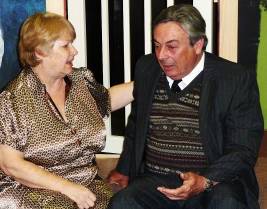 Take Thor, who complains about a family physician so “lousy” that he “didn’t even say I had to give up smoking,” to which wife Cora responds in all sincerity, “Well, that’s silly. Everybody knows you ought to give up smoking.”
Take Thor, who complains about a family physician so “lousy” that he “didn’t even say I had to give up smoking,” to which wife Cora responds in all sincerity, “Well, that’s silly. Everybody knows you ought to give up smoking.”
Take Ida, who’s finally convinced Homer to bring his girlfriend of a dozen years (and fiancée of the past seven) with the threat of making him “eat his dinners in town for a whole month” because, having seen a movie about an “old bachelor” who shoots himself (starring John Wayne no less!), she worries that Homer might do the same.
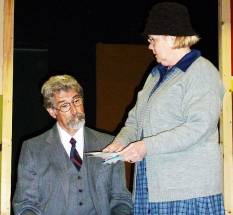 Take David, who, discovering Esther at her sisters’, vows to make good on his threat to force her to move upstairs, if only she will let him climb the stairs now and then for an occasional bath.
Take David, who, discovering Esther at her sisters’, vows to make good on his threat to force her to move upstairs, if only she will let him climb the stairs now and then for an occasional bath.
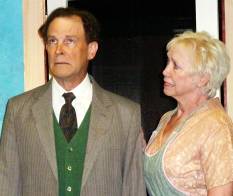 Take Carl, whose “spells” have him banging his head against a tree as he bemoans not having taken “the fork” and picked a different life path. “That’s not so much to ask!” he moans. “Just to be a dentist. Charlie Watson went on and became a dentist! But I wasn’t up to it!”
Take Carl, whose “spells” have him banging his head against a tree as he bemoans not having taken “the fork” and picked a different life path. “That’s not so much to ask!” he moans. “Just to be a dentist. Charlie Watson went on and became a dentist! But I wasn’t up to it!”
These thoroughly delicious characters are brought to life on the Sierra Madre Playhouse stage by a cast of SMP vets: Roxanne Barker, Sandra Hakman, Gloria Dennison, and Jinny Wilcott as sisters Cora, Arry, Ida, and Esther; Guy Crawford, Jack Chanseler, and Don Savage as Thor, Carl, and David; and Robert Kerr and Patricia Wylie as Homer and Myrtle.
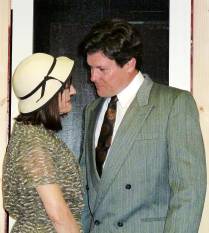 These veteran thesps are mostly marvelous choices for their roles, the entire bunch avoiding the temptation to overplay their quirks as they create authentic relationships that mirror the cast’s histories together on the Sierra Madre stage. Only the age-inappropriate casting of Hakman and Wylie puts considerable strain on credibility, though both otherwise make strong impressions.
These veteran thesps are mostly marvelous choices for their roles, the entire bunch avoiding the temptation to overplay their quirks as they create authentic relationships that mirror the cast’s histories together on the Sierra Madre stage. Only the age-inappropriate casting of Hakman and Wylie puts considerable strain on credibility, though both otherwise make strong impressions.
Jack Hakman and Hakman Designs Of Chicago have created a simple but attractive Midwest set, though its painted-on lawn and a lack of any interior decoration in Carl and Ida’s house prove distracting, particularly when floorboards creak outdoors and characters are forced repeatedly to duck under a black curtain where a door ought to be. Kim Smith and Kim McKibben’s lighting design does the job, though it lacks the richness L.A. theatergoers may be accustomed to seeing in similar scale productions. Anachronistic women’s hairdos (with the possible exception of Barker’s short bob) detract from the authenticity of costume designer Lois Tedrow’s terrific late 1930s Midwest garb. Steve Shaw scores high marks for his subtle sound design.
Once again, a Sierra Madre Playhouse program misleadingly places asterisks after the names of all 4-A Union members—Actors’ Equity, SAG/AFTRA, and AGVA—rather than Equity members only as specified in the Los Angeles 99-Seat Theatre Plan.
Keeping things moving smoothly backstage are stage manager Michael Dessin and assistant stage manager Emilie Brazeau.
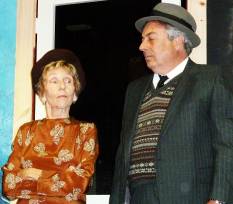 Few plays about to celebrate their 75th birthday hold up as well as Morning’s At Seven, which could just as easily have been written in 2012 as a period piece as way back in 1939. As performed on the Sierra Madre Playhouse’s classic proscenium stage, Paul Osborn’s classic seems scarcely to have aged a day, let alone three quarters of a century.
Few plays about to celebrate their 75th birthday hold up as well as Morning’s At Seven, which could just as easily have been written in 2012 as a period piece as way back in 1939. As performed on the Sierra Madre Playhouse’s classic proscenium stage, Paul Osborn’s classic seems scarcely to have aged a day, let alone three quarters of a century.
Sierra Madre Playhouse, 87 W. Sierra Madre Blvd., Sierra Madre.
www.sierramadreplayhouse.org
–Steven Stanley
April 13, 2012
Photos: Ward Calaway


 Since 2007, Steven Stanley's StageSceneLA.com has spotlighted the best in Southern California theater via reviews, interviews, and its annual StageSceneLA Scenies.
Since 2007, Steven Stanley's StageSceneLA.com has spotlighted the best in Southern California theater via reviews, interviews, and its annual StageSceneLA Scenies.







 COPYRIGHT 2025 STEVEN STANLEY :: DESIGN BY
COPYRIGHT 2025 STEVEN STANLEY :: DESIGN BY